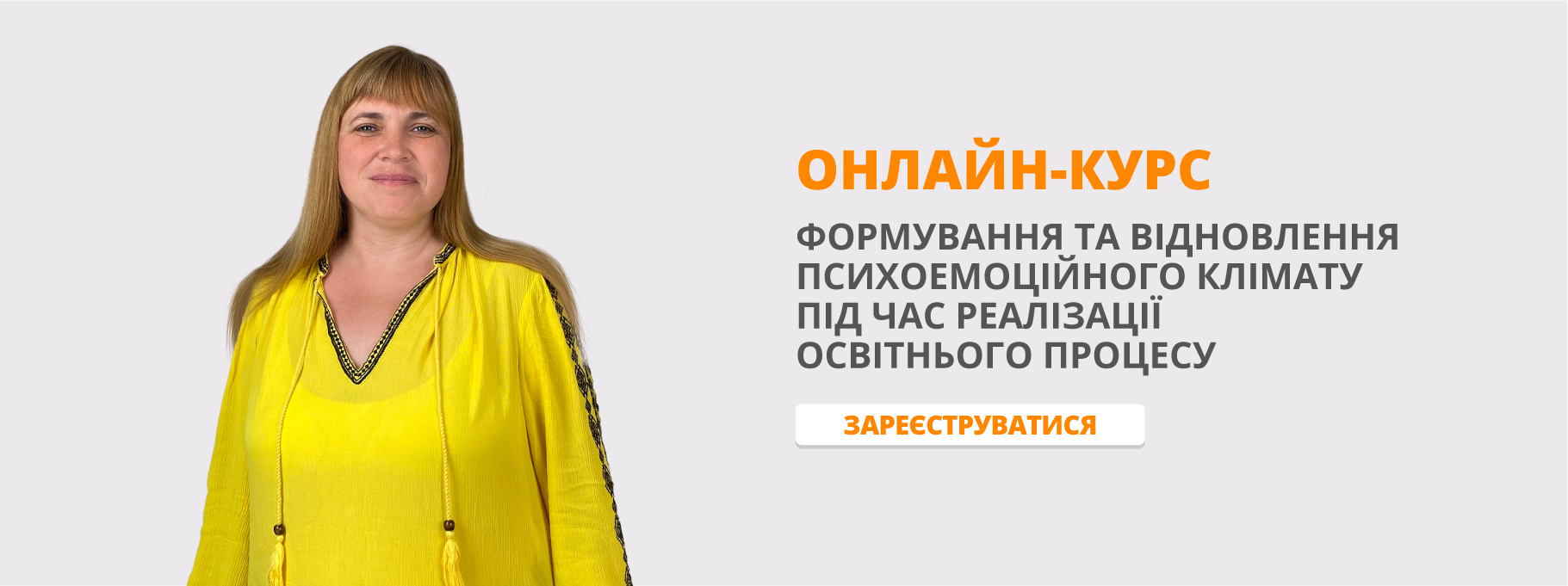«Information and Сommunication Technology»
Урок розроблено для учнів 11 класу. Підручник: Get 200! Автори: Марта Росінска, Лінда Едвардс (Macmillan education). Практична мета:
- Систематизувати лексичний матеріал;
- Удосконалювати навички монологічного та діалогічного мовлення;
- Розвивати вміння вести групову бесіду;
- Удосконалювати вміння формувати висловлювання;
- Розвивати в учнів швидку мовленнєву реакцію.
Комунальний заклад
«Навчально-виховне об'єднання –
«Загальноосвітня школа І-ІІІ ступенів № 31 з гімназійними класами,
центр дитячої та юнацької творчості «Сузір'я»
Кіровоградської міської ради Кіровоградської області»
Відкритий урок у 11-ому класі
вчителя англійської мови
Кісєєвої Н.В.
на тему:
«Information and Сommunication Technology»
Кропивницький, 2018
Тема уроку: Information and communication technology
Клас: 11
Підручник: Get 200! Автори: Марта Росінска, Лінда Едвардс (Macmillan education).
Мета:
Освітня мета:
- Збільшувати знання дітей з соціокультурних особливостей англо- мовних країн;
- Розширювати кругозір учнів;
- Розвивати вміння логічного викладу думок з теми;
- Розвивати мислення учнів.
Розвиваюча мета:
- Розвивати увагу, пам’ять, логічне мислення, мовленнєву реакцію і мовну здогадку;
- Удосконалювати уміння здійснювати проблемно-пошукову діяльність;
- Аналізувати здобуту інформацію.
Виховна мета:
- Прививати любов до англійської мови;
- Виховувати повагу до людей, традицій і цінностей різних країн;
- Виховувати зібраність, самовладання, комунікативність ( уміння працювати в колективі );
- Виховувати позитивне ставлення учнів до навчально-пізнавальної діяльності;
- Виховувати уміння сконцентруватися, слухати інших, співпереживати, формувати сприятливий моральний клімат.
Практична мета:
- Систематизувати лексичний матеріал;
- Удосконалювати навички монологічного та діалогічного мовлення;
- Розвивати вміння вести групову бесіду;
- Удосконалювати вміння формувати висловлювання;
- Розвивати в учнів швидку мовленнєву реакцію.
Тип уроку: комбінований.
Технічне забезпечення: комп’ютер, планшети для учнів, мультимедійна дошка, картки.
Початок уроку
Hello, pupils! I am very glad to see you. I hope you are fine, full of energy and ready to submit new heights. Today we will continue talking about modern technologies, particularly about hand-held devices and new generation that is called “Thumb generation”. During the lesson, we are going to use the gained knowledge and information for holding the discussion, practise pair and group work, improve speaking, reading, writing and listening skills and develop critical thinking.
Основна частина уроку
1.Warming-up.
T.: Look at the board. Here we can see different idioms concerning information and communication technology. At first, let us try to guess their meaning and what situations we can use them in. Do the matching
On the run- always moving, never resting.
Bright as a button- intelligent
Silver suffer- an elderly person who uses Internet
Downwardly mobile - losing wealth and status
Upwardly mobile- gaining wealth and status
P1: I think “bright as a button” means intelligent. We can say that a person is clever, confident in different spheres of human life. I can say that my father is bright as a button because he is an engineer and knows much about engines and technical devices.
P2: I know for sure what “a silver suffer” means. My granny is the one. She is very active in social networking sites and knows how to reboot a computer. A silver surfer is an elderly person who uses Internet.
P 2: “On the run” means always moving, never resting. We are all on the run. We chat on the phone while we go to the bus stop. We text messages while we cook. We do much simultaneously.
T: So, you are a “Thumb generation”. Do you agree with this notion? Are you part of “Thumb generation”? Are you active users of handhelds? All these devices are widely used by people, especially by kids, so called “Thumb generation”. Can you explain this term?
P 1: The use of mobile phones and other technology has made people use their thumbs more and more. These electronic devices have made it necessary for us to rely on the thumb to type, and have established the thumb’s high place in the hierarchy of the hand
T: How are younger people’s fingers changing?
P2: The thumb is the preferred tool of 21st - century communication. The younger generation has grown up sending text messages through mobile phones and playing video games on consoles, where the finger that is most used to play the game, is the thumb.
P3: It is the generation born after 1985. As wireless mobile devices are small, the thumbs are generally used to type. This led to the use of acronyms to decrease typing time.
2.Vocabulary activities
T: Let’s review the most popular devices and notions used by the “Thumb generation”, open your books page 74, the part “Information and communication technology” (підручник “Get 200!”, Macmillan education)
Task 13. P. 74 (example)
Cross out one verb in each group that does not collocate with the nouns in bold.
- Open/ save/ edit/ reply to a file
- Send/ start up/ reply to/ forward an email
- Copy/ browse/ connect to/ link up to the internet
Task 16. P. 74 (example)
Choose the correct words to complete the sentences.
- I text a lot, so I use prediction/ predictive texting because it’s much faster to text your message.
- I often use instant/ immediate messaging with my mates.
- My brother uses his computer to flow/ stream live sporting events
Task 17. P.74
Complete the sentences with the correct words in the box.
T: Look at the screen, name the most popular devices used by the “Thumb generation” and explain what they are used for. Do not forget to use the words we have just reviewed.
P 1: A handheld computer is a computer that can conveniently be stored in a pocket and used while you are holding it. Today's handheld computers can be divided into those that accept handwriting as input and those with small keyboards
P 2: A GPS navigation device is a device that receives Global Positioning System (GPS) signals to determine the device's location on Earth. GPS devices provide latitude and longitude information, and some may also calculate altitude.
P 3: iPod Touch: Touch screen handheld computer with access to thousands of apps.
P 4: Nintendo DS: Popular gaming device. The latest version features a camera.
P 5: PDA: Personal Digital Assistant. This is a small handheld computer. These have largely been surpassed by smartphones.
P 6: Smartphone, a phone and mini-computer combined, with internet access. Most phones now come with cameras, MP3 players, calendars, calculators, note pads and other tools.
P 7: Sony PlayStation Portable. This is a handheld gaming device but has very powerful multimedia capabilities, the option to add a camera, an MP3 and video player, an integrated web browser and other features.
P 8: iPod Apple’s MP3 player that can do so much more than just play MP3s.
P9: Netbooks: HP Mini note Smaller, laptop-style devices.
P10: Tablet computers: Apple iPads or other Android or Windows tablets.
3. Reading
Pre-reading.
T.:I see you are quite confident with modern devices but can you imagine having flexible computer screens and mobile phones which change shape to tell you when you have a new message? It sounds like a crazy idea, but in fact it's already been invented! Take the tablet computers and log on the British council (https://learnenglishteens.britishcouncil.org/uk-now/science-uk/flexible-screen-technology). Next exercise we will do online. The first task is to match the words with the definitions.
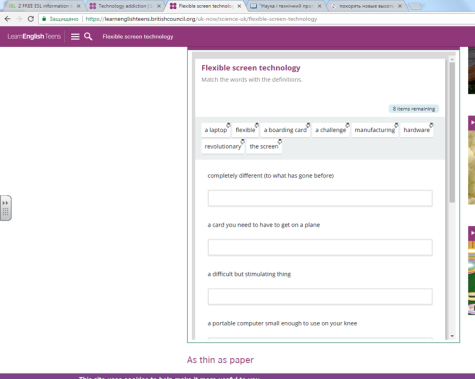
While reading
(Додаток 1- текст для читання.)
Mark the words, which have been mentioned today and reviewed at the beginning of the lesson.
Post reading
Task 1
Choose the correct phrase to complete the sentences.
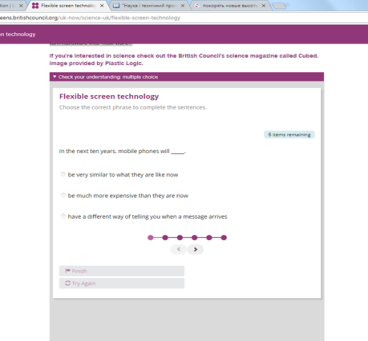
Task 2
Are the sentences true or false?
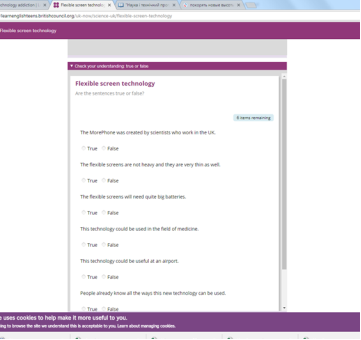
4. Dialogues
T.: Pupils, what do you think about such futuristic trends. Would you like to have such flexible screen computers? What are the advantages or disadvantages of such gadgets? Work in pairs and dream with your partner about our nearest future.
While dramatizing the dialogues, the rest of the class should be very attentive and fill in the following table.
(Додаток 2)
5.Listening (Watching a video)
Pre listening
T.: You think that technologies are very important for our life and it is clear from your dialogues. Can we say that you are addicted to your gadgets? Can you define the point where we must stop and have real communication in real life?
P.1: It is easier to communicate via Internet. If you want to stop it, you just log off. Sometimes I forget to do my chore because I surf the net.
T.: Now we are going to watch a video about technology addiction. Do you have friends with such problems? Are you addicted to computers and Internet? Before watching a small video let us do some tasks taken from the Internet. (https://learnenglishteens.britishcouncil.org/study-break/video-zone/technology-addiction)
T.: Match the wards with definitions.
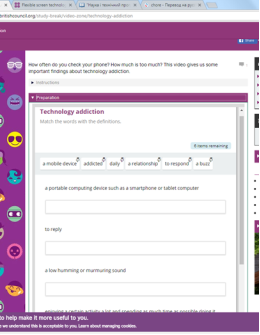
While listening
T.: Watch the video and name the social networking sites, which will be mentioned there.
Post-listening
Check your understanding.
Task 1
Are these sentences true or false?
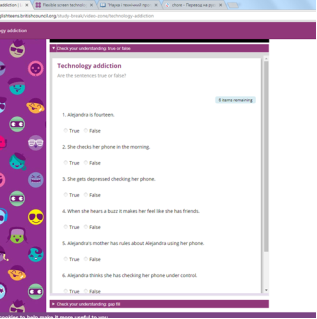
Task 2
Fill the gaps with the correct number from the box.
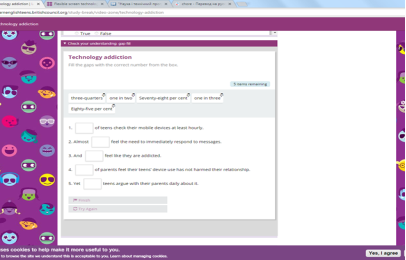
Task 3
Discussion
T.:How often do you check your phone?
Do you think phone addiction is a serious problem?
How much is too much?
6.Writing
T: Well done. From the previous video we can guess that the girl chats much and to be quick she uses abbreviated forms of the words. Now let us have some fun and a kind of competition. Work in groups again. Using standard English, rewrite the text messages two people sent to one another.
Man: DO U WAN2 C ME L8R 4 A DRINK?
Woman: WOT RU TRYING 2 SAY
Man: I LUV U
Woman: OIC:-O
Man: PCM
Woman: IM W/ SOME1
Man: WOT ABOUT YR FRIEND? I LOVE HER 2
IS SHE W/ NE1?
Woman: I H8 U:
7.Discussion (Group work)
T.: Work in three groups and try to define the future of
- Social sites
- PC
- Phones
You can use colored pencils to draw a picture of your future or some pictures from the Internet in your tablet computers.
Заключна частина уроку
T.: It was very interesting to listen to your versions of our future. You are as bright as buttons and I hope you will be upwardly mobile. Your discussion was very interesting and I think it will be interesting for other pupils of our school to read them. At home, write an article about the future of our gadgets and their impact on us. Use pictures to make it bright and we will download your articles on our school site for everybody to read. I hope we will have feedback and read many comments. Our lesson has come to its end. Your marks are…
Thank you very much for being here, that was a great pleasure to work with you.Using emoticon, my reflection of the lesson is See you next lesson. Good bye.
Додаток 1
As thin as paper
In the future, the mobile phone will be our flexible friend. It will be able to change shape to tell us when we receive a message. A model called MorePhone has been created by scientists at the Human Media Lab in Canada. It’s based on flexible plastic technology developed in Cambridge in the UK by an organisation called Plastic Logic. Rachel Lichten, who works at Plastic Logic, describes how the scientists there have developed a process for manufacturing flexible plastic displays which are as thin as paper. They copy the appearance of writing on paper and use a type of plastic to create layers of electronic transistors.
Screens you can jump on
The flexible screens can be any size, and are easy to read in direct sunlight. They can be black and white or colour and are very thin and light – Lichten says you can even jump on them. They use very little power, so there is no need for large batteries, and this makes them easy to carry around. Lichten says this technology could be used for heart monitoring, smart-watches, second screens for mobile phones – because the image does not disappear, your phone can keep your boarding card details for a flight for example even when your phone’s battery is dying. Plastic Logic is also working with a Japanese company who make giant electronic signs.
Next generation of electronic gadgets
Plastic Logic have spent 13 years developing this new technology. Their challenge now is to help customers to think of new ways to use it. Lichten says it is always the same with new technologies. She says ‘bringing new technology to the market is a challenge, especially because it is revolutionary. However, for the next generation of products, you have to know what the next generation of products will be.’ Working with mobile phones or laptops that can roll up like a piece of paper could turn hardware into ‘flexi-ware’.
Додаток 2
|
|
Pupils |
The ideas mentioned in the dialogue about our future and about the flexible computers
|
|
Dialogue 1
|
|
|
|
Dialogue 2
|
|
|
|
Dialogue 3
|
|
|
|
Dialogue 4
|
|
|
|
Dialogue 5
|
|
|


про публікацію авторської розробки
Додати розробку
